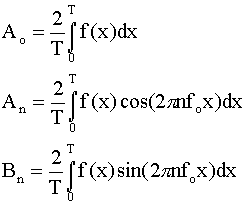Jan 22, 2001
If have periodic function f(x), it can be expressed as a Fourier
series:

where can get the coefficients:

by using the fact that the sines and cosines are orthogonal over their
periods.

If the function f(x) is not periodic, then have to use the integral
form:

which are called a Fourier transform pair. Notice that in this case
all frequencies are present in the transform, not just the harmonic frequencies
found in the Fourier series.
f(x) is usually a real function, but F(w) is complex. F(w) can be expressed
in terms of a real and an imaginary part, and also as having magnitude and phase
components.
Because the range of |F(w)| is generally very large, the display of |F(w)|
on a monitor usually is transformed to show: D(w) = log(|F(w)| + 1).

Generally, when using Fourier transforms for image processing, have to use
finite sampled series. Discrete sampled forms of the Fourier transforms can be
obtained by applying the point, pulse, and comb functions:
Point: 
Pulse: rect(x/a) = 1 for
 ,
0 otherwise
,
0 otherwise
Comb:

Start with a continuous f(x) that is bandwidth limited, get F(w).
Sample f(x) using the comb function with a spacing of a, this
will make F(w) periodic.
Truncate the sampled data to N samples by using the rect
function, this will extend lobes on F(w) from sinc function effect.
Sample F(w) using the comb function with a spacing of 1/a, this will
make f(x) periodic.

Two-Dimensional Fourier Transform
In two dimensions, the Fourier transform pair is expressed as

Last modified on January 24, 2001
